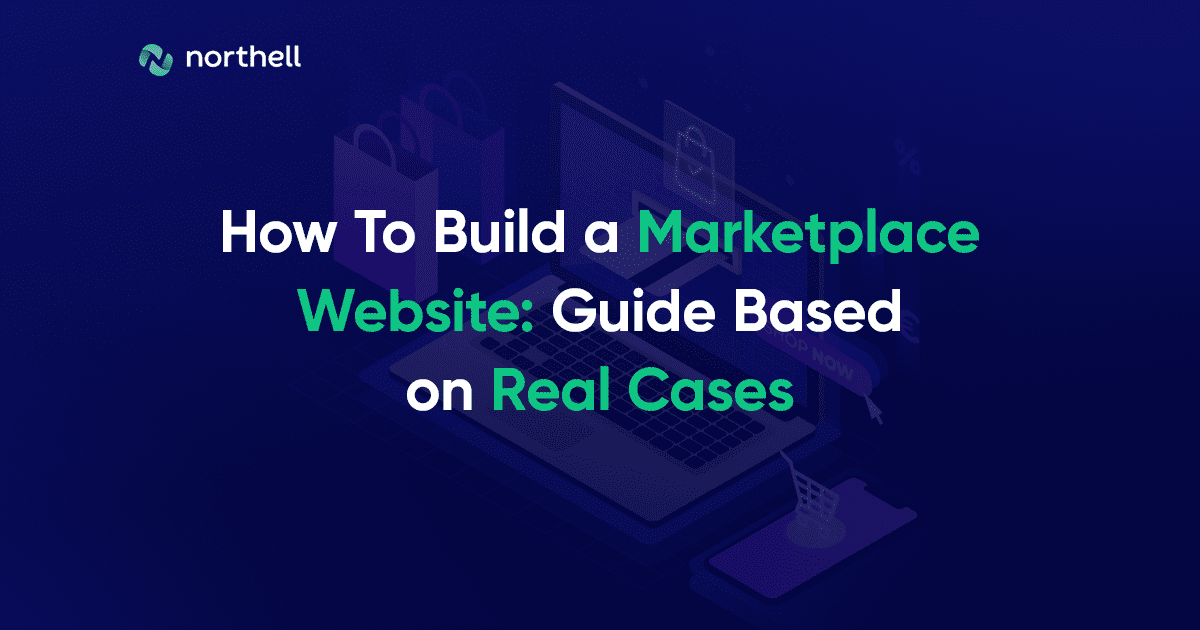Content
In 2019, more than half of online sales went through online platforms – marketplaces, which brought the global economy $1.7 trillion. Such trends have turned the creation of a marketplace to promote products or services into a profitable business investment.
How to Build a Marketplace Website: General Overview
According to iBe, online marketplaces will exceed $7 trillion in sales by 2024. Nowadays, many people are thinking about how to build a marketplace website. In our new article, we will try to help you understand this issue.
What is an online marketplace website?
Building an online marketplace is a pretty challenging process. To find out how to build a marketplace website, firstly, let’s analyze what a marketplace is.
Marketplace is an online retail platform. Similar to a hypermarket, this is a place where a variety of goods/products from different sellers are offered around the clock, but only online. Sellers get a great platform to promote their products, and buyers get essential goods that can be bought in one place.
What are the types of custom marketplace development?
To create a marketplace website, you should know what types of marketplaces exist. In addition to its owner, two parties are involved in any marketplace: one acts as a customer, the other as a supplier. The scale and specifics of this interaction may be different depending on who is selling products or providing services to whom.
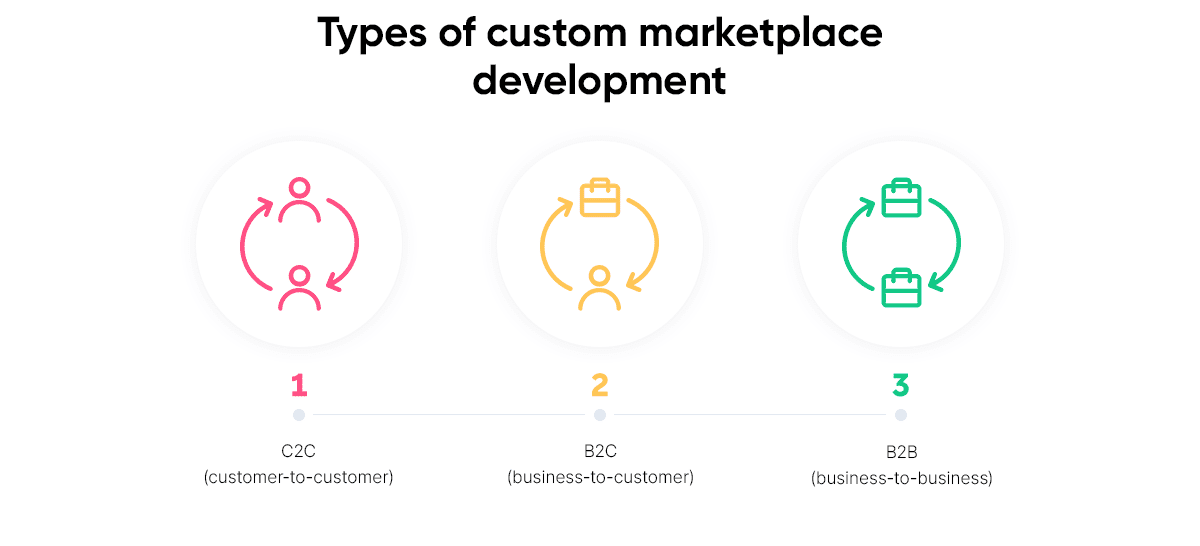

What are the types of custom marketplace development?
Each marketplace is based on one of three basic models:
- C2C (customer-to-customer);
- B2C (business-to-customer);
- B2B (business-to-business).
In the C2C model, both parties are individuals who interact with each other on equal terms. Common interests unite them. They cooperate on mutually beneficial terms and can easily change roles: today, you are a buyer, and tomorrow you are a seller. Examples of C2C marketplaces are Amazon, Alibaba and eBay.
In the case of B2C marketplaces, individuals remain customers, but entrepreneurs act as suppliers. The prime example is AliExpress, where you can find thousands of products from T-shirts to motorcycles on one site. They are produced and posted for sale by many different companies.
Sometimes B2C and C2C models are mixed on the same site. For example, Airbnb offers rental properties not only from individuals but also from individual entrepreneurs or agencies.
Some of them started cooperation with the marketplace as individuals but then decided to turn additional income into a full-fledged business.
The B2B model connects entrepreneurs and allows them to find successful solutions for their businesses. Such sites meet customers looking for wholesale suppliers or large contractors and sellers who need new markets.
To know how to build a marketplace website, let’s also analyze trends in the online marketplace market.
How to Build a Marketplace Website with RewiSoft [Our Experience & Cases]
RewiSoft team has great experience in building custom marketplaces. We know how to build a marketplace website that will be scalable, high-functioning and visually appealing.
RewiSoft worked on the following projects:
- Launch. Launch enables students and young professionals to be connected with companies in a fast, direct, and seamless manner. The platform helps students explore the best companies tailored to their needs, manage direct communication with them, and ensure suitability and trustworthiness through insights and testimonial sections.
- ProFlourish. ProFlourish is a job search platform where job seekers connect with the entrepreneurial team. The platform helps companies and organizations find their ideal candidates.
- HelpPays. It is a marketplace for short-term peer-to-peer loans. No intermediary is needed to conduct loans. With HelpPays, people can lend each other money for different needs without the involvement of banks.
- Agent Scout. AgentScout is a US real estate platform where users can buy or sell real estate with the help of the best agents in their region. New users automatically get three agents to choose from for further work. Agents help solve different types of user problems related to real estate.
- Needl. It is a platform that currently works in the FMCG retail market, creating business opportunities, namely leads between buyers and sellers.
Accordingly, if available, they can view in which stores what kind of products they can buy, select them and order, selecting the date and time of delivery. The users also have the opportunity to track their orders.
To bring this project to life, we worked on the following areas:
- Attractive UX/UI design. Any marketplace should be visually appealing and have a well-thought-out user experience. While working on the 1kauf project, we made a big focus on choosing the right colors for the website interface and building easy product navigation.
- Responsive design. We paid a lot of attention to creating a responsive design so that users can easily order products using their mobile phones or other devices. We also tested the product several times to ensure that the marketplace works smoothly regardless of the screen size.
- Robust information architecture. Since the 1kauf marketplace contained a variety of functionality, many modules and categories, our team built a great information architecture that streamlined all the content of the website and its functional part.
Another customer, Launch, required UI/UX design for the website and mobile application of the marketplace platform. Launch enables students and young professionals to be connected with companies in a fast, direct, and seamless manner.
The platform helps students explore the best companies tailored to their needs, manage direct communication with them, and ensure suitability and trustworthiness through insights and testimonial sections.
To bring our customer’s idea to life, we worked on the following areas:
- Student-centric design. The main requirement of the customer was to craft a student-centric design to ensure simple and user-friendly functionality with seamless and convenient navigation for users. Considering this requirement we offered a design solution to expand students’ searches based on their preferences and allow them to spot new companies for building deep and future-proof connections.
- Responsive design. Our team designed a responsive web app for a digital matchmaking platform allowing students and young talents to improve their prospects and visibility for companies.
- Scalable information architecture. In order for our customer to be able to scale their project in the future, we created a robust information architecture and thus organized all the content and functionality of the marketplace platform.
If you don’t know how to build a marketplace website and need an experienced team, contact us. Our design and development team will be happy to perform your project!
The RewiSoft development process looks like this:
- Product discovery. Before we begin developing a marketplace website, we extensively study and confirm your concept at this stage.
- Technical documentation. During this stage of the full-stack development process, our team chooses technical stacks, prepares the estimate and defines the scope of work.
- Development. Our front-end and back-end developers write code for both the server and client product sides.
- Testing. We use advanced technologies to conduct performance testing, functionality testing, usability testing, compatibility testing, etc.
- Delivery. Our project managers monitor the work of developers to guarantee that the project is finished on schedule.
In general, RewiSoft team can provide you with the following services:
- Web development. We deliver impactful and customized web development services for leading companies across a wide range of industries.
- Digital design services. We assist companies in visualizing even the most original ideas, transforming them into stunning compositions and unforgettable experiences.
- Mobile app development. Our team can help your company create effective applications for mobiles. We employ specialists with a high level of knowledge in the field of modern technologies.
- Quality assurance services. With a well-established quality assurance approach, we have assisted worldwide organizations in gaining predictability, increasing performance, drastically lowering overall testing costs, and achieving more significant ROI.
How to Build a Marketplace Website in 8 Easy Steps
How to build a marketplace website that will help you get big profits? Here are eight steps that you should follow to create a marketplace website.
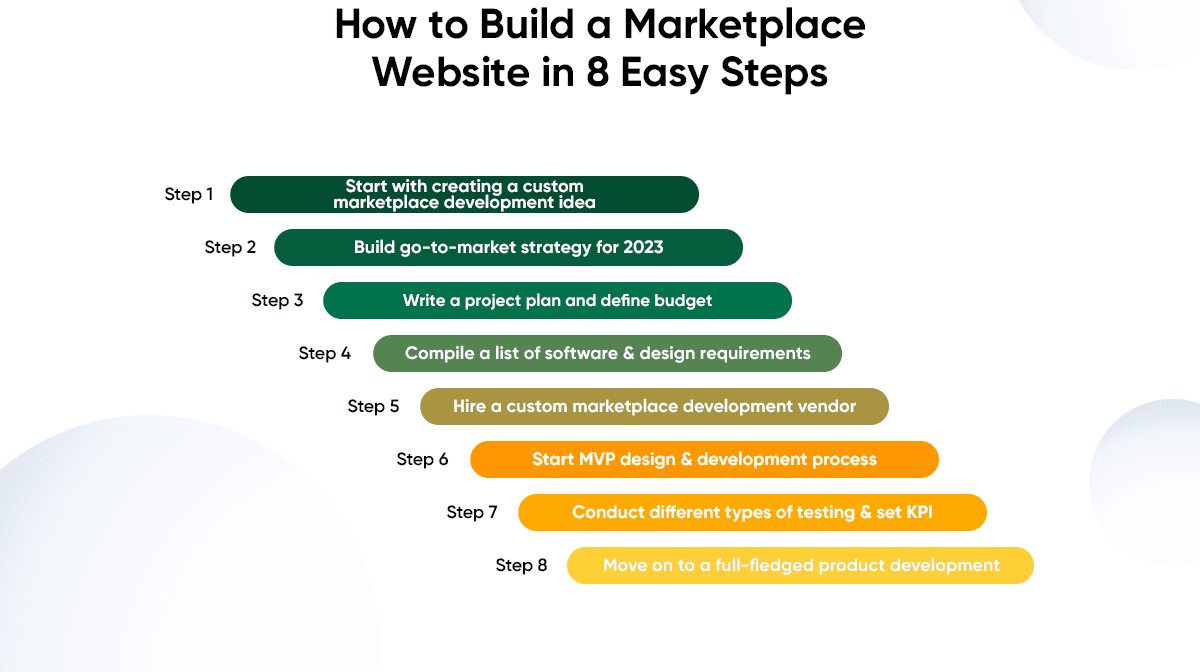

How to Build a Marketplace Website in 8 Easy Steps
Step 1: Start with creating a custom marketplace development idea
Any product always starts with an idea. The marketplace is no exception. First, you should think about what exactly you want to create, what type of marketplace you need, what exactly you should add to it, etc. In the process of creating your product, it will be easier for you to customize the whole process since you will know what kind of end result you want to get.
Step 2: Build go-to-market strategy for 2023
Go-to-market is a strategy for companies that seek to convey their value proposition to the target audience, achieve advantages over competitors, and sell a product or service. This technique is often used when launching a new product that no one has heard of before.
Many blogs and studies provide information on outdated methods that no longer work. We recommend that you stick to a go-to-market strategy while building an online marketplace, as this technique will help you successfully create a product.
What questions should you get answers to when launching a GTM strategy?
- For whom are you creating this product?
- Why exactly this product?
- Who is the buyer?
To implement this strategy, you need to go through several stages:
- Business case and product fit
- Market strategy
- Pricing strategy
- Marketing plan
- Customer journey
- Roadmap
- KPIs
Step 3: Write a project plan and define budget
Your next step should be to plan and budget for the project. You should describe each step and each process. A good plan is always the key to success. It is also essential to understand how much money you need to complete the project and for each process of building an online marketplace. If you skip this step, you will always be at a loss and possibly lose time and money.
A project plan usually includes the following processes:
- Defining the main goal (why are you creating a product)
- Hiring the specialists you need or the whole team
- Business analysis
- Defining and prioritizing functionality
- Design creation
- MVP development
- Testing
- Bug fixes and final release
Step 4: Compile a list of software & design requirements
Next, you should write down the requirements for your product. It is very important for the team that will work on your products to understand what you want, what features you need in the marketplace, what design you prefer, etc. Usually, the design requirements (specifications) document includes the following things:
- Full project overview
- Main needs and goals
- Target audience
- Functional requirements and desired set of features
- Aesthetic aspects
- Non-functional details
- Recommendation and prohibitions
- Questions
To know how to write the design specification, read our article How To Write The Design Specification? [Quick Guide].
Step 5: Hire a custom marketplace development vendor
The next step is finding and hiring a team for your project. You need to take this issue seriously because you risk failing the project if you choose the wrong specialists. When hiring a design and development team, carefully check the portfolio of specialists, reviews, project results, etc.
If you need a team of professionals and a reliable partner, contact us. RewiSoft team has successfully completed more than 155 projects, and we guarantee you fruitful and efficient cooperation.
Step 6: Start MVP design & development process
When you have hired the specialists you need for your project, you can start MVP design and development. Gathering information through MVP costs a lot cheaper than developing a full-fledged product with a large set of functions. MVP allows us to reduce costs and risks and, with a competent approach, eventually come up with a business idea that works.
MVP design and development process include such stages:
- Product discovery & business analysis;
- Selecting the main functionality and features for your MVP product;
- Target audience defining;
- UX design, users’ flow creation, prototyping;
- UX testing;
- UI design;
- Front-end development;
- Back-end development;
- QA
- Launching.
The MVP is excellent mistake prevention in any area. It will help you engage people, understand the strengths and weaknesses of the product, and increase the likelihood of future success. To know more details about MVP design and development, read our article How To Create a Minimum Viable Product (MVP)? [Startup Case Studies].
Working on the Launch project, the main goal was to create UX/UI design from scratch and build the business logic. Equipped with market/competitors’ research details provided by the client and leveraging feedback from the target audience, we created high-level desktop wireframes considering users’ needs.
Afterwards, once wireframes were approved by the client, we started the UI design process utilizing a mobile-first approach in order to maximally adapt the responsive design. Our designers enhanced and complemented the web application correspondingly.
We helped the Launch team come up with a simple and memorable logo based on our design solutions. RewiSoft team made UI design of the web application straightforward using a white background with black text and orange buttons to make concise accents.
Step 7: Conduct different types of testing & set KPI
After developing the MVP, the product must be thoroughly tested. Possible errors must be identified and corrected. It is also worth setting KPIs. With the help of KPIs, you can measure the company’s performance as a whole, individual department, and directly employees, and motivate staff to achieve the required results.
Step 8: Move on to a full-fledged product development
Once you test your idea with MVP, get feedback from users and understand what you need to fix in the product, you can start creating a full-fledged product. For this, of course, you will need more time and money, an excellent team of specialists, resources, etc. However, creating a full-fledged product with an MVP at hand is much easier than doing it from scratch.
What are The Main Trends in Custom Marketplace Development?
Building an online marketplace is very popular nowadays. New entrants to the marketplace market need to take into account trends in online trading:
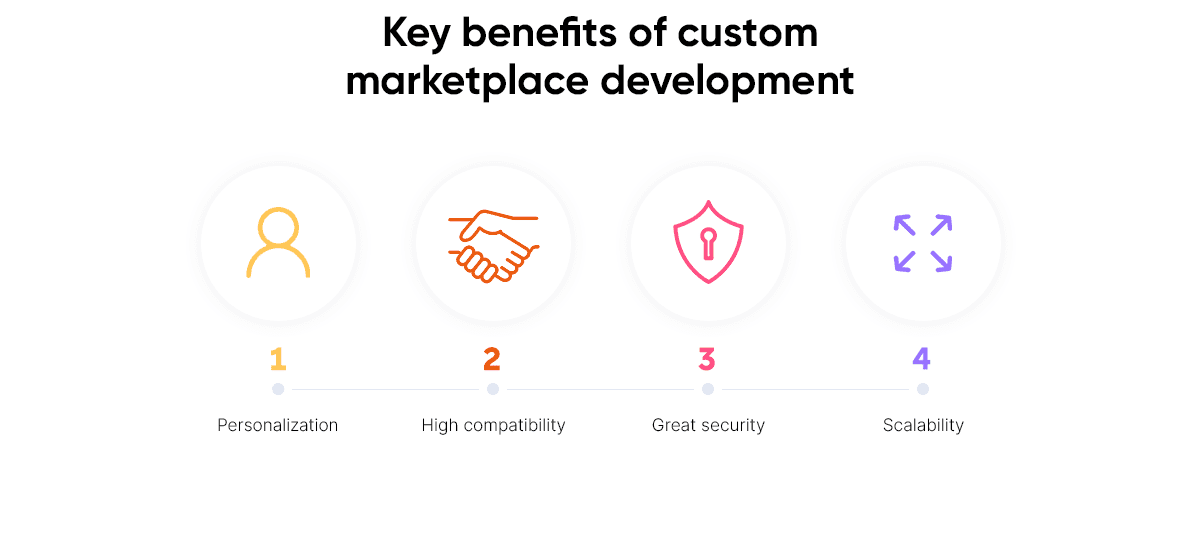

What are The Key Benefits of Custom Marketplace Development?
Combination of online and offline trading
The 2020 pandemic showed that despite the convenience of online trading, people miss the opportunity to spend time in a fitting room or discuss a product with a seller. Those marketplaces that find the opportunity to invest in physical presence and their own distribution will benefit.
Augmented reality
Augmented reality is gradually becoming our everyday reality. A client who can see in advance how a piece of furniture will look in his apartment or how a hat sits on his head most likely will not return the product as unsuitable.
Voice search and image search
This trend has arisen against the backdrop of our constant employment and spontaneity in decision-making. Marketplaces that take it into account will win the competition.
Shopping from a mobile device
Mobile shopping is replacing shopping from the desktop. People buy from a smartphone, standing in traffic, or waiting for their turn at the dentist. Marketplaces should take this into account when investing in the mobile version of their site. Or better yet, create an app.
What are The Key Benefits of Custom Marketplace Development?
Considering the present marketplace industry growth, it is more profitable if you create your own marketplace. Here are the main benefits of a custom online marketplace.
Personalization
You can create a marketplace website based on your company’s needs and requirements. Also, thanks to custom marketplace development, you can personalize the user experience and adjust the platform to the desires and needs of users.
High compatibility
Your marketplace may be designed to work with a variety of devices, external services, and tools. Thanks to customization, you can make your marketplace absolutely compatible with all additional integrations and tools.
Great security
While ready-made solutions provide subpar security, custom marketplace development provides a wide range of options for protecting your marketplace against fraud and criminal activities.
Scalability
A custom marketplace will be able to manage a large number of listings as well as a rising number of clients, which is critical to the company’s growth. Thanks to customization, in the future, you will be able to scale your project by adding new functionality and rebuilding the information architecture.
How to Build a Marketplace Website with Basic Features
Since there are many different types of marketplaces and all may have completely different functionality, we have prepared a list of basic features that definitely need to be included:
Admin panel for buyers and sellers
This feature is the basis of the marketplace. The panel should be easy to use and user-friendly. You don’t need to add too many elements. Laconicism and minimalism are now the main trends.
History of activities on the platform
The activity history will help the user always be aware of what he has already purchased or sold, with whom he interacted previously, etc.
System of feedback and recommendations
This feature will help users identify good and dishonest sellers/buyers. Thanks to reviews and recommendations, the chances are increased that the user will find exactly the product he needs.
Support for all payment methods
We suppose each of us at least once faced the problem of payment on the marketplace. So that your users do not leave immediately after encountering a payment problem, you should set up the support for all payment methods well, that can immediately help the user to deal with the problem and successfully pay for the goods.
Customer support and dispute resolution
Here is almost the same as in the previous paragraph. To prevent users from leaving your marketplace website when the first problem appears, you need to set up your customer support well.
Protection from criminals
Unfortunately, today there are a lot of cybercrime fraudsters increasing every year. For your work not to be wasted, you need to set up the security system of your marketplace properly.
1-click purchase system
This feature allows users to save time on purchasing a product. Nowadays, people are very busy and often shop on the way home in a traffic jam or at lunchtime at work. The faster and more convenient they can make a purchase, the more likely they are to return to the site again.
If you need help choosing the functionality for your marketplace, please get in touch with us. We will help you decide based on your needs and requirements.
How to Build a Marketplace Website with Advanced Features
Nowadays, some users will not be satisfied with the basic functionality. We have compiled a list of advanced and modern features that will help you make your marketplace website more popular and in demand.
Price comparison
If your marketplace contains a large number of identical products, we advise you to add functionality that will help users compare the prices of the same products only from different suppliers. Thus, users using this filter will be able to find what suits their budget quickly.
Sharing in social networks
By adding this functionality to your marketplace website, you give users the opportunity to share, for example, some promotions from your website on their social networks. Thus, you get an additional channel of advertising and, consequently, traffic.
Buyer’s behavior analysis
This feature is required for sellers. It allows merchants to evaluate and analyze customer behaviors (e.g., purchase frequency or products most purchased by specific customers) and improve their sales strategy or product offerings.
Advanced product management
Sellers will benefit greatly from this feature, as they will be able to add, duplicate, change and save descriptions of multiple products on a single page, for example. Also, thanks to customized templates, they will be able to manage their products faster and better.
Technical Requirements for Custom Marketplace Development
We have created a checklist that will help you create a marketplace website correctly from the technical side. Here are 4 website technical requirements to check off while establishing your new marketplace website:
SSL certificate
An SSL, or Secure Sockets Layer, certificate installed on your website validates its identity and allows an encrypted connection to be established between a web server and a web browser. It ensures that all web communication between your web server and the user’s browser is encrypted and unreadable. It protects login information, any information input on a form, and transactions.
Website hosting service
A website hosting service allows you to safely store the data that comprise your website (images, HTML files, and so on) while also allowing you to run your site live on the internet.
Before you choose a website hosting provider, you should know what sort of hosting you want, how much storage you’ll need, and whether or not they offer an SSL certificate in their charge. A quality website hosting provider will be fast, secure, and dependable.
XML Sitemap
An XML Sitemap is a website sitemap that directs search engines to all of your relevant pages. It helps search engines index your site and discovers content more quickly, improving the likelihood that Google and other search engines will find your page.
Browser compatibility
A browser, such as Google Chrome, Safari, or Firefox, is a software application that allows you to access the World Wide Web. When you establish a new website, you must ensure that it shows and performs properly across all browsers.
How to Build a Marketplace Website Without Mistakes
Building an online marketplace is a challenging process. Our team shared the main things that you should pay maximum attention to when building an online marketplace.
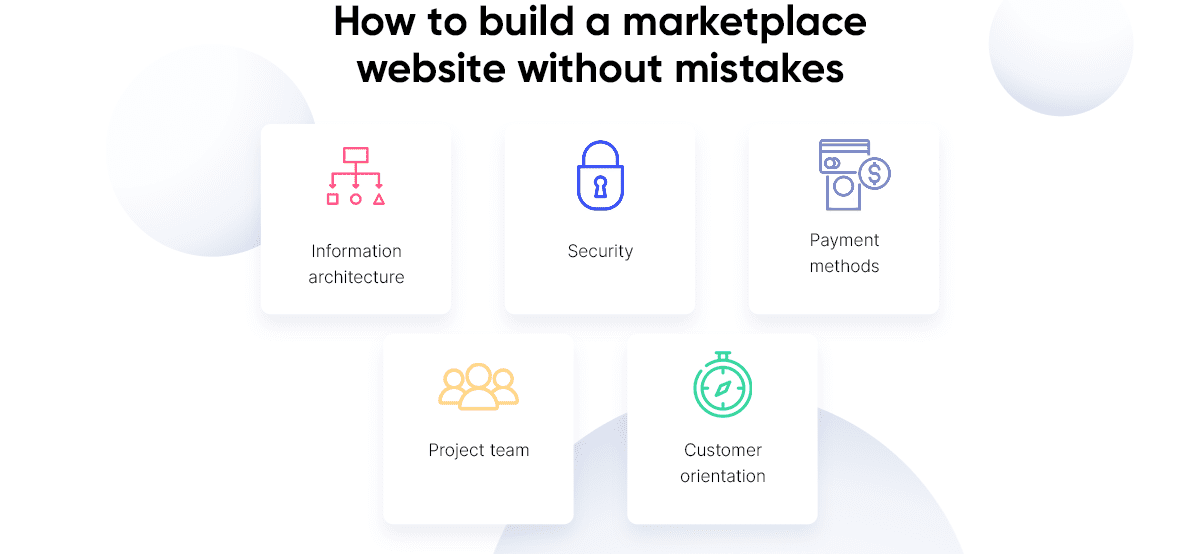

How to Build a Marketplace Website Without Mistakes
Information architecture
Building an information architecture is one of the most important processes that should not be forgotten during custom marketplace development. Thanks to a well-formed information architecture in advance, you will be able to create a scalable marketplace with organized content and functional parts.
We often compare building a product architecture to an architectural plan for a skyscraper. It is really impossible to build a good building without an architectural plan, right?
Security
It is very important that your marketplace is safe for both buyers and sellers. As we said earlier, the number of scammers is growing every year. A well-configured security system on your site will help prevent fraud from any side and allow users to make purchases or sell goods safely.
Payment methods
The first thing to decide when launching a marketplace is whether the payment will take place on your website or the supplier’s website. If you decide that payment through your platform is necessary, you will need to decide on the payment methods and select the step in the checkout process at which the payment will take place.
Due to the wide geography, credit cards are the most common method of payment in the world. They are particularly well suited for online payments as payment companies provide a wide range of fraud protection services.
In addition to credit cards, other payment methods are used for online payments:
- E-wallets
- Internet banking
- Cash upon receipt
- Project team
A good team is a key to successful product creation. In addition to selecting qualified specialists for various processes of creating a marketplace, you also need to think about a team that will technically support your product after its release. This should be a team that can help solve any problem that you or your marketplace users face.
Usually, a project team consists of:
- BA (Business Analyst)
- UX designer
- UI designer
- Frontend developer
- Backend developer
- QA engineer
Customer orientation
Remember, for your product to be valuable and useful to people, you need to be customer-oriented. The service center should include the two main users (buyer and seller), and you should give them the same amount of time and attention.
How Much Does it Cost to Build a Marketplace Website?
The cost of custom marketplace development can vary greatly depending on the direction of the business and the required functionality, so it is impossible to give an exact development figure. However, we have compiled a table of approximate prices for different stages of development, depending on the country in which the design and development team is located.


Rough project costs
If we are talking about the prices for individual areas of development, then the numbers will be as follows:
- Front-end development – $53/hr
- Back-end development – $65/hr
- Full-stack development – $60/hr
If we are talking about the prices for using a specific technical stack, then the numbers will be as follows:
- React.Js – $47/hr
- React Native – $47/hr
- Angular.Js – $47/hr
- Node.Js – $47/hr
- Vue.Js – $44/hr
- Python – $52/hr
- Java – $48/hr
- Kotlin – $47/hr
How Long Does it Take to Build a Marketplace Website?
Let’s also consider how long custom marketplace development takes. Of course, everything here depends on the experience and skills of your design and development team, the size of your project, its complexity, etc. For your convenience, we calculated how much time each stage of marketplace creation will take for different sizes of businesses:


Our work estimate
Having this information in mind, you can calculate the approximate development cost and timeline of the entire project.
The Best Examples of Custom Marketplace Development
We have selected a few examples of successful marketplaces for inspiration. Let’s take a look at them.
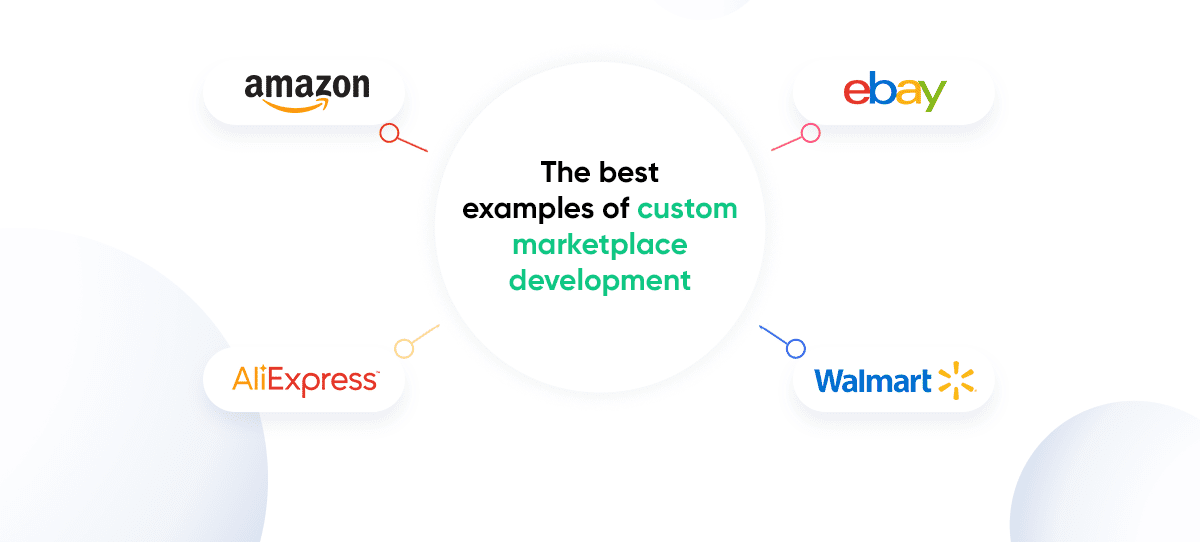

The Best Examples of Custom Marketplace Development
Amazon
Amazon is the largest international online platform with approximately 1.5 million visitors every month. The assortment of the marketplace consists of more than 30 product categories. Both individuals and legal entities can sell on Amazon.
Ebay
Ebay is a large American marketplace where goods are sold not only at fixed prices but also as part of an online auction. The auction format will be an effective solution for single sales of unique products.
The platform’s main advantage is a huge audience, among which you can find buyers even for rare and non-standard offers. About 177 million people actively use the system.
Aliexpress
Aliexpress is a popular Chinese marketplace with online retailers from all over the world. Up to 200,000,000 visitors visit the site every month. The site cooperates with organizations, individual entrepreneurs, and the self-employed. To connect a store, you need to register, accept the offer agreement and provide documentation.
Walmart
Walmart is a large Western retail chain and flagship American hypermarket. It has been operating in the marketplace format since 2016.
Now it houses a variety of brands and stores from 30 countries around the world. The assortment is constantly expanding with new partners.
Walmart accounts for up to 27,000 visits per month per seller. Walmart recently acquired the popular Jet marketplace and further expanded its functionality.
How to Build a Marketplace Website: Summary
The demand for marketplaces continues to grow, which leads to the emergence of new applications and websites. There are many competitors in this niche, and if you are determined to enter it, you need a quality product that effectively addresses the specific needs of your target audience.
If you follow the steps we have described, you will have more chances of finding your place in the market. Don’t be afraid to make mistakes, constantly improve your app, stay on top of current trends and listen to your users. And if you need help in building an online marketplace, the RewiSoft team is ready to start collaborating with you! Just contact us, and we will together decide on the best solution for your business!

